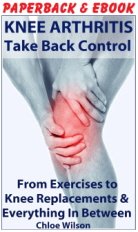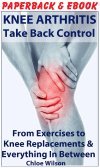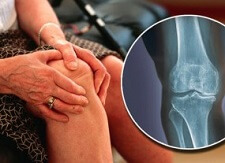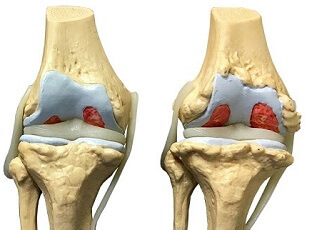- Home
- Knee Arthritis
- Symptoms
Knee Arthritis
Symptoms & Diagnosis
Written By: Chloe Wilson, BSc(Hons) Physiotherapy
Reviewed by: KPE Medical Review Board
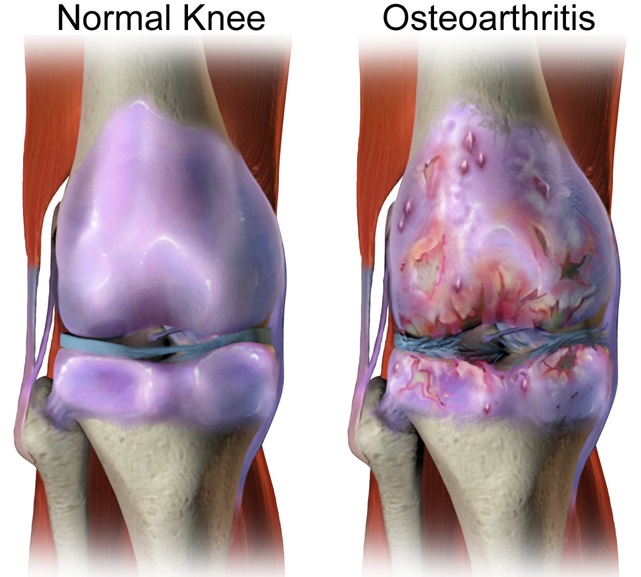
Knee arthritis symptoms vary greatly from person to person and even day to day. Some days there may be no pain at all, other days you may be in agony.
You may find that there is something in particular that aggravates your symptoms, or you may feel there is no pattern at all.
Osteoarthritis is the most common cause of knee pain in the over fifties age group, affecting approximately sixteen million people worldwide.
Arthritis is commonly known as "wear and tear" and is caused by thinning and inflammation of the cartilage lining the knee joint and the associated bony spurs that develop around it, making the knee stiff and sore.
Here we will look at how the most common symptoms of knee arthritis and how the disease is diagnosed. To find out more about what arthritis is, what causes it and the best treatment option, visit the knee arthritis guide.
Common Knee Arthritis Symptoms
Knee arthritis symptoms vary massively between people and often fluctuate, but common symptoms include:
1. Knee Pain
Pain is the most common of all knee arthritis symptoms and is typically felt when trying to fully bend or straighten the knee e.g. squatting, and with activities where lots of weight goes through the knee e.g. going up and down stairs or running.
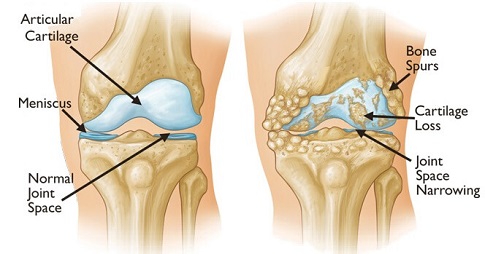
The knee is often sore when you touch it with arthritis and pain levels tend to fluctuate.
People often describe knee arthritis pain as being like a nagging toothache.
Knee pain from arthritis may affect part or all of the knee joint, depending on where the arthritis damage is. It is very common for knee arthritis to be mainly concentrated on the medial side of the knee, resulting in inner knee pain. This is because more force tends to go through the medial side of the knee making it more prone to damage and wear and tear.
There are a number of things you can do to reduce the pain - visit the arthritis treatment section to find out more.
2. Knee Stiffness
Another one of the most common knee arthritis symptoms is stiffness which can limit how much you can bend and straighten your knee. Knee stiffness first thing in the morning or after prolonged inactivity e.g. sitting for long periods is a classic feature of knee arthritis.
Knee arthritis symptoms of stiffness are usually caused by a combination of knee bones spurs impeding joint movement and a lack of joint lubrication.
Knee stiffness associated with arthritis usually eases after a few minutes of moving around. Doing gentle exercises when you first wake up or when you are sitting can really help reduce this stiffness. LEARN MORE >
3. Knee Swelling
Knee swelling is another common feature of arthritis. The swelling tends to fluctuate and can cause pain and restricted movement. Again, as with pain, there may be generalised swelling all around the knee, or the swelling may be more focused on one area, typically either front knee swelling or medial knee swelling. Ice and tubigrip can really help to reduce the swelling associated with arthritis and thus reduce knee arthritis symptoms.
4. Weakness & Instability
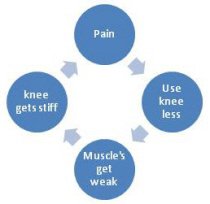
Arthritis can cause weakness and instability around the knee, and the knee may give way at times.
A vicious cycle often exists with knee arthritis where due to pain, we move around less so the muscles get weak and the joint stiffens. Then it hurts more so we do even less and the muscles get weaker still.
Strengthening exercises for the knee muscles can help to reduce this and are one of the most effective treatments for knee arthritis. LEARN MORE >
5. Fluctuating Symptoms
People often find their knee arthritis symptoms vary greatly. Some days they feel fine, other days they are in complete agony.
Knee arthritis symptoms are often worse during:
- Bad weather: the thinking behind this is that the change in air pressure affects the pressure in our joints
- When we are stressed/anxious/tired: During these times chemicals are released in our body that make us feel pain more
- When we are unwell: inflammatory chemicals are often released into our system when we are ill, increasing arthritis knee pain
Diagnosing Knee Arthritis
Check Out Our Book
All the info you need about knee arthritis, top tips, exercises & loads more.
Rated 4.4/5
Find Out More
Your doctor will be able to diagnose knee arthritis from:
- Your History:
the information you give about your knee arthritis symptoms such as the location of
the pain, activities that make it better or worse and what it feels
like
- Physical Presentation: the movements, strength and shape of your knee
If knee arthritis is suspected, your doctor will normally arrange for an x-ray which will confirm or deny the diagnosis.
However, it is important to know that what the x-ray shows often bears little correlation with what knee arthritis symptoms people feel. For more information about this, visit the arthritis stages section.
Find Out More
Here we have concentrated on knee arthritis symptoms and diagnosis but you can find out loads more about beating knee arthritis pain in the following sections:
- Arthritis Book: Everything you need to know in a handy book
- Arthritis Overview: Introduction to Arthritis
- Causes of OA: What causes arthritis?
- Stages of OA: How the disease and symptoms progress
- Treatment Options: Whole range of ways to treat arthritis knee pain
- Diet For Arthritis: Which foods to avoid and which foods can help
- Knee Replacements: Replacing an arthritic knee with a new one
Page Last Updated: 11/06/23
Next Review Due: 11/06/25
